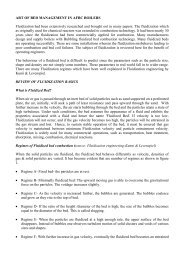You also want an ePaper? Increase the reach of your titles
YUMPU automatically turns print PDFs into web optimized ePapers that Google loves.
There are various patterns <strong>of</strong> flow that exist <strong>in</strong>side <strong>tubes</strong>. The patterns are def<strong>in</strong>ed with respect to<br />
orientation <strong>of</strong> <strong>tubes</strong>.<br />
FLOW PATTERN IN VERTICALLY ORIENTED TUBE<br />
The common flow patterns for vertical upward flow, which is when the boiler tube is oriented vertical,<br />
are as shown <strong>in</strong> figure 1. As the quality, that is steam to water ratio <strong>in</strong>creases, the flow patterns change<br />
from bubbly to wispy annular flow. In the boiler the steam / water ratio that is prevail<strong>in</strong>g <strong>in</strong> the<br />
particular circuit along with the mass flux would have decided the flow pattern <strong>in</strong>side tube.<br />
Undoubtedly, the flow has to be bubbly flow so that the water / steam flow well mixed <strong>in</strong>side tube<br />
without any steam blanket<strong>in</strong>g <strong>in</strong>side the tube. Otherwise the metal temperature would go up result<strong>in</strong>g<br />
<strong>in</strong> tube bursts.<br />
Bubbly flow: the steam / water bubbles are uniform <strong>in</strong> size.<br />
Slug / Plug flow: the steam flows as large bullet shaped bubble. Also the steam bubbles prevail as<br />
small bubbles <strong>in</strong> water. This flow pattern is also called plug flow.<br />
Churn flow: Highly unstable flow <strong>of</strong> oscillatory <strong>in</strong> nature. The water near the tube walls cont<strong>in</strong>uously<br />
pulses up and down.<br />
Annular flow: The liquid travels partly as annular film on the walls <strong>of</strong> the tube and partly as small<br />
drops distributed <strong>in</strong> the steam which flows <strong>in</strong> the centre <strong>of</strong> the <strong>tubes</strong>.<br />
Wispy- annular flow: As the water flow rate is <strong>in</strong>creased <strong>in</strong> annular flow, the concentration <strong>of</strong> drops <strong>in</strong><br />
the steam core <strong>in</strong>creases. Ultimately the droplet concentration <strong>in</strong> the core leads to large lumps or<br />
streaks / wisps <strong>of</strong> water <strong>in</strong> the steam core. The flow pattern is the characteristic <strong>of</strong> <strong>high</strong> mass flux.<br />
FLOW PATTERN IN HORIZONTALLY ORIENTED TUBE<br />
The phases tend to separate due to density difference caus<strong>in</strong>g a form <strong>of</strong> stratified flow to be very<br />
common. This makes the heavier water phase to accumulate at the bottom <strong>of</strong> tube. When the tube is<br />
<strong>in</strong>cl<strong>in</strong>ed at an angle the pattern the slug / plug flow is common. The common flow patterns <strong>in</strong><br />
horizontal <strong>tubes</strong> are illustrated <strong>in</strong> figure 2.<br />
Flow patterns vary from that <strong>of</strong> vertical <strong>tubes</strong> due to gravitational forces which act perpendicular to the<br />
direction <strong>of</strong> flow. As the steam fraction <strong>in</strong>creases, the flow pattern changes from Plug to annular flow.<br />
Plug flow: The <strong>in</strong>dividual steam bubbles have coalesced to produce long plugs. The steam bubbles<br />
tend to flow along the top <strong>of</strong> the tube.<br />
Stratified flow: the steam to water <strong>in</strong>terface is smooth.<br />
Wavy flow: the stratified flow may not rema<strong>in</strong> smooth for long as the steam fraction <strong>in</strong>creases, the<br />
flow becomes wavy.<br />
Slug flow: the wave amplitude is so large that the wave touches the top <strong>of</strong> the tube.<br />
Dispersed bubble flow: many small steam bubbles are distributed uniformly across the entire tube<br />
cross section when the steam and water velocities are <strong>high</strong>.<br />
Figure 3 is the very well known representation <strong>of</strong> the steam bubble behavior <strong>in</strong>side a horizontally<br />
oriented tube. It is the designer’s job to design the evaporation circuit with proper downcomer and<br />
riser arrangements, evaporator tube arrangements to ensure the nucleate boil<strong>in</strong>g prevails <strong>in</strong> each part<br />
<strong>of</strong> the boil<strong>in</strong>g circuit.<br />
WHAT CAN HAPPEN INSIDE THE BED TUBE UNDER VERY LESS HEAT INPUT?<br />
When the velocity <strong>in</strong>side the tube is less, the steam bubble may rise to the top and form a bubble<br />
adher<strong>in</strong>g to tube wall at 12 o clock position. In vertically oriented tube the steam bubble would get <strong>in</strong> to

















